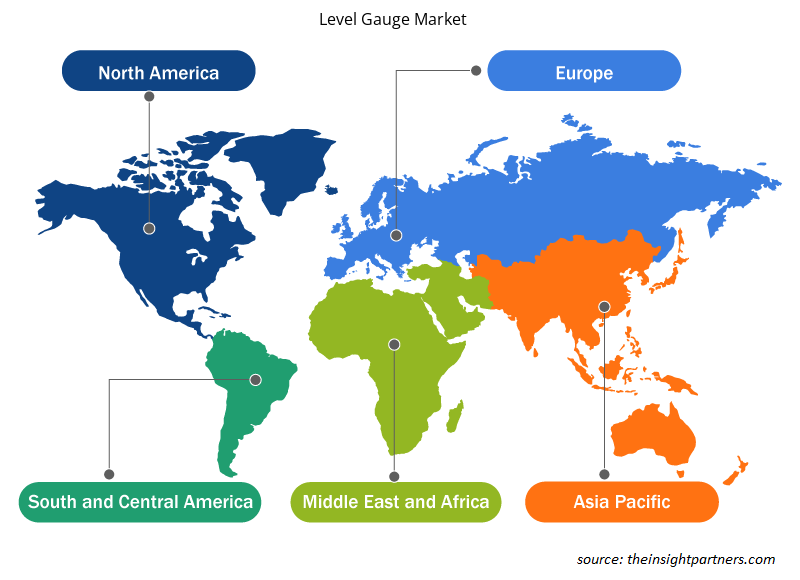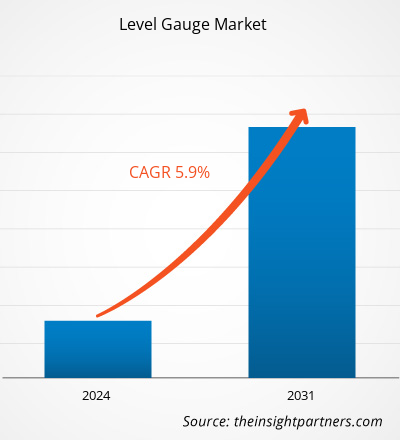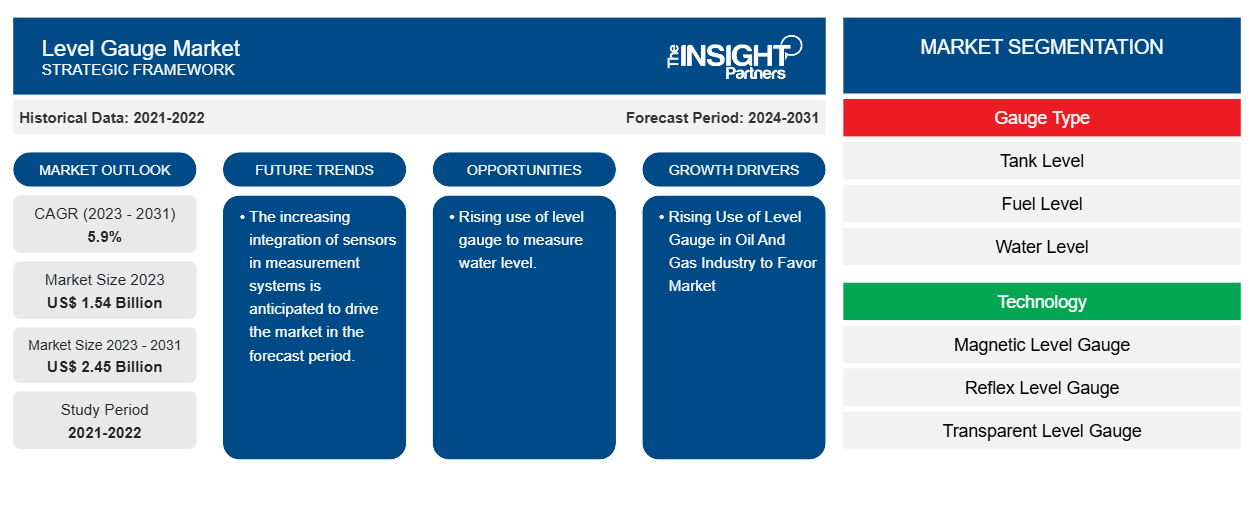레벨 게이지 시장 규모는 2023년 15억 4천만 달러에서 2031년 24억 5천만 달러로 성장할 것으로 예상됩니다. 이 시장은 2023~2031년 동안 5.90%의 CAGR을 기록할 것으로 예상됩니다. 석유 및 가스 산업에서 레벨 게이지 사용이 증가하고 자동 탱크 게이지 시스템이 확대 배치되는 것은 시장의 주요 추세와 원동력으로 남을 가능성이 높습니다.
레벨 게이지 시장 분석
게이지 시장은 전 세계적으로 상당한 성장을 경험하고 있습니다. 이 성장은 다음에 기인합니다.석유 및 가스 산업에서 레벨 게이지 사용이 증가하고 자동 탱크 게이지 시스템이 배치되는 것이 증가하고 있습니다. 또한 수위를 측정하기 위한 레벨 게이지 사용이 증가하고 측정 시스템에 센서를 통합하는 것이 향후 몇 년 동안 시장 성장을 견인할 것으로 예상됩니다.
레벨 게이지 시장 개요
레벨 게이지는 탱크나 다른 저장 용기의 유체 레벨을 감독하는 데 사용되는 측정 및 감지 장치입니다. 이러한 계측기는 탱크, 드럼, 압력 용기 및 기타 유사한 응용 분야의 유체 레벨을 모니터링하기 위해 산업 공정 응용 분야에서 자주 사용됩니다. 게이지는 헤드, 플로트, 줄자, 바닥 고정 브래킷, 가이드 와이어, 엘보, 앵커, 커플러, 파이프 지지 브래킷 및 파이프를 포함한 수많은 부품으로 구성됩니다.
귀하의 요구 사항에 맞게 이 보고서를 사용자 정의하세요
이 보고서의 일부 또는 국가 수준 분석, Excel 데이터 팩을 포함하여 모든 보고서에 대한 사용자 정의를 무료로 받을 수 있으며 신생 기업 및 대학을 위한 훌륭한 혜택과 할인 혜택을 이용할 수 있습니다.
-
이 보고서의 주요 시장 동향을 알아보세요.이 무료 샘플에는 시장 동향부터 추정 및 예측까지 다양한 데이터 분석이 포함됩니다.
레벨 게이지 시장 동인 및 기회
석유 및 가스 산업에서 레벨 게이지 사용이 증가하면서 시장이 활성화되었습니다.
오일 레벨 게이지는 충전 레벨을 모니터링하고 작동 상황을 감지하는 데 사용됩니다. 빠르고 쉬운 시각적 제어가 가능하며 오일 또는 오일 흐름이 있는 시스템과 함께 다른 매체에도 사용할 수 있습니다. 옵션 반사경은 가시성이 좋지 않은 경우에도 레벨을 쉽게 읽을 수 있도록 합니다. 또한 대기 탱크에 수동 탱크 게이징 프로세스를 활용할 수 있으며, 이는 주변 조건에서 보관할 수 있는 오일 및 석유화학 제품 에 적합합니다 . 기존 방법은 투명한 레벨 게이지와 줄자를 사용하여 충전 레벨을 계산하는 것입니다. 예를 들어, 수동 방법을 사용하여 투명 게이지가 내장된 원통형 플로팅 루프 탱크의 원유 레벨을 측정할 수 있습니다. 이로 인해 석유 및 가스 산업에서 레벨 게이지에 대한 수요와 사용이 증가합니다.
수위를 측정하기 위해 수위계를 사용하는 경우가 증가하고 있습니다.
수위계는 수로, 수로 또는 웨어의 수위를 빠르게 시각적으로 표시합니다. 보다 정확한 수위 측정 장치가 있는 경우에만 의존해서는 안 되지만, 수위계를 사용하면 작업자가 상대적인 수위를 빠르게 측정한 다음 다른 작업을 진행할 수 있습니다. 또한 전자 수위 측정 게이지가 시장에 출시되고 있습니다. PCB 회로 기판, 공통 전극, 감지 전극, 에폭시 수지 , 금속 쉘, 케이블 등으로 구성된 새로운 유형의 수위 측정 센서입니다. 따라서 수위 측정에서 수위계에 대한 높은 요구 사항을 고려할 때, 향후 몇 년 동안 시장이 성장할 것으로 예상됩니다.mwasurement of water level, the market is anticipated to grow in coming years.
레벨 게이지 시장 보고서 세분화 분석
레벨 게이지 시장 분석에 기여한 주요 세그먼트는 게이지 유형, 기술 및 최종 사용자입니다.
- 게이지 유형에 따라 레벨 게이지 시장은 탱크 레벨, 연료 레벨, 수위 및 기계적 레벨로 구분됩니다. 탱크 레벨 세그먼트는 예측 기간 동안 상당한 시장 점유율을 차지할 것으로 예상됩니다.
- 기술에 따라 레벨 게이지 시장은 자기 레벨 게이지, 반사 레벨 게이지, 투명 레벨 게이지, 표형 레벨 게이지 등으로 구분됩니다. 자기 레벨 게이지 세그먼트는 예측 기간 동안 상당한 시장 점유율을 차지할 것으로 예상됩니다.
- 최종 사용자별로 시장은 석유 및 가스, 식품 및 음료, 화학 및 석유화학, 해양, 에너지 및 전력, 기타로 세분화됩니다. 석유 및 가스는 예측 기간 동안 상당한 시장 점유율을 차지할 것으로 예상됩니다.
지역별 레벨 게이지 시장 점유율 분석
레벨 게이지 시장 보고서의 지리적 범위는 주로 북미, 아시아 태평양, 유럽, 중동 및 아프리카, 남미 및 중부 아메리카의 5개 지역으로 나뉩니다.
북미는 레벨 게이지 시장을 지배해 왔습니다. 북미 레벨 게이지 시장은 미국, 캐나다, 멕시코로 세분화되어 있습니다. 이 시장은 이 지역에서 성장하고 있으며, 성장은 석유 및 가스 산업에서 레벨 게이지 사용이 증가하고 자동 탱크 게이지 시스템이 배치되는 것이 증가한 데 기인합니다. 게다가 미국과 캐나다의 선진 경제권에서 연구 개발에 중점을 두면서 북미 업체는 기술적으로 진보된 솔루션을 시장에 내놓을 수밖에 없습니다. 게다가 미국에는 혁신적인 솔루션 개발에 점점 더 주력하고 있는 많은 레벨 게이지 시장 업체가 있습니다. 이러한 모든 요소가 이 지역의 레벨 게이지 시장 성장에 기여합니다.
레벨 게이지 시장 지역 통찰력
Insight Partners의 분석가들은 예측 기간 동안 레벨 게이지 시장에 영향을 미치는 지역적 추세와 요인을 철저히 설명했습니다. 이 섹션에서는 북미, 유럽, 아시아 태평양, 중동 및 아프리카, 남미 및 중미의 레벨 게이지 시장 세그먼트와 지리에 대해서도 설명합니다.

- 레벨 게이지 시장에 대한 지역별 데이터 얻기
레벨 게이지 시장 보고서 범위
| 보고서 속성 | 세부 |
|---|---|
| 2023년 시장 규모 | 15억 4천만 달러 |
| 2031년까지 시장 규모 | 24억 5천만 달러 |
| 글로벌 CAGR (2023-2031) | 5.9% |
| 역사적 데이터 | 2021-2022 |
| 예측 기간 | 2024-2031 |
| 다루는 세그먼트 |
게이지 유형별
|
| 포함된 지역 및 국가 |
북아메리카
|
| 시장 선도 기업 및 주요 회사 프로필 |
|
시장 참여자 밀도: 비즈니스 역학에 미치는 영향 이해
레벨 게이지 시장은 소비자 선호도의 변화, 기술 발전, 제품의 이점에 대한 인식 증가와 같은 요인으로 인해 최종 사용자 수요가 증가함에 따라 빠르게 성장하고 있습니다. 수요가 증가함에 따라 기업은 제품을 확장하고, 소비자의 요구를 충족하기 위해 혁신하고, 새로운 트렌드를 활용하여 시장 성장을 더욱 촉진하고 있습니다.
시장 참여자 밀도는 특정 시장이나 산업 내에서 운영되는 회사나 기업의 분포를 말합니다. 주어진 시장 공간에 얼마나 많은 경쟁자(시장 참여자)가 존재하는지 그 규모나 전체 시장 가치에 비해 나타냅니다.
레벨 게이지 시장에서 운영되는 주요 회사는 다음과 같습니다.
- ABB 유한회사
- 바크스데일 주식회사
- 아이바즈
- 빈마스터
- JBJ 테크닉스 유한회사
- 조글러, 유한회사
면책 조항 : 위에 나열된 회사는 어떤 특별한 순서에 따라 순위가 매겨지지 않았습니다.

- 레벨 게이지 시장 주요 주요 업체 개요를 알아보세요
레벨 게이지 시장 뉴스 및 최근 개발
레벨 게이지 시장은 1차 및 2차 연구 이후의 질적, 양적 데이터를 수집하여 평가합니다. 여기에는 중요한 기업 간행물, 협회 데이터 및 데이터베이스가 포함됩니다. 레벨 게이지 시장의 몇 가지 개발 사항은 다음과 같습니다.
- BM26A-8000을 출시하면서 KROHNE은 2023년에 새로운 BM26A 시리즈 자기 레벨 표시기(MLI)의 시장 출시를 완료했습니다. 이전 세대를 대체하는 이 장치는 특정 산업 요구 사항에 따라 설계되었습니다. (출처: KROHNE Messtechnik GmbH 회사 웹사이트 2023년 6월)
레벨 게이지 시장 보고서 범위 및 제공물
"레벨 게이지 시장 규모 및 예측(2021-2031)" 보고서는 아래 영역을 포괄하는 시장에 대한 자세한 분석을 제공합니다.
- 범위에 포함된 모든 주요 시장 세그먼트에 대한 글로벌, 지역 및 국가 수준의 레벨 게이지 시장 규모 및 예측
- 레벨 게이지 시장 동향 및 드라이버, 제약 및 주요 기회와 같은 시장 역학
- 자세한 PEST/포터의 5가지 힘과 SWOT 분석
- 주요 시장 동향, 글로벌 및 지역 프레임워크, 주요 업체, 규정 및 최근 시장 개발 사항을 포괄하는 레벨 게이지 시장 분석
- 시장 집중도, 히트맵 분석, 유명 업체 및 레벨 게이지 시장의 최근 개발 사항을 포함하는 산업 환경 및 경쟁 분석
- 자세한 회사 프로필
- 과거 분석(2년), 기준 연도, CAGR을 포함한 예측(7년)
- PEST 및 SWOT 분석
- 시장 규모 가치/거래량 - 글로벌, 지역, 국가
- 산업 및 경쟁 환경
- Excel 데이터세트
최근 보고서
사용 후기
구매 이유
- 정보에 기반한 의사 결정
- 시장 역학 이해
- 경쟁 분석
- 고객 인사이트
- 시장 예측
- 위험 완화
- 전략 기획
- 투자 타당성 분석
- 신흥 시장 파악
- 마케팅 전략 강화
- 운영 효율성 향상
- 규제 동향에 발맞춰 대응























 무료 샘플 받기 - 레벨 게이지 시장
무료 샘플 받기 - 레벨 게이지 시장